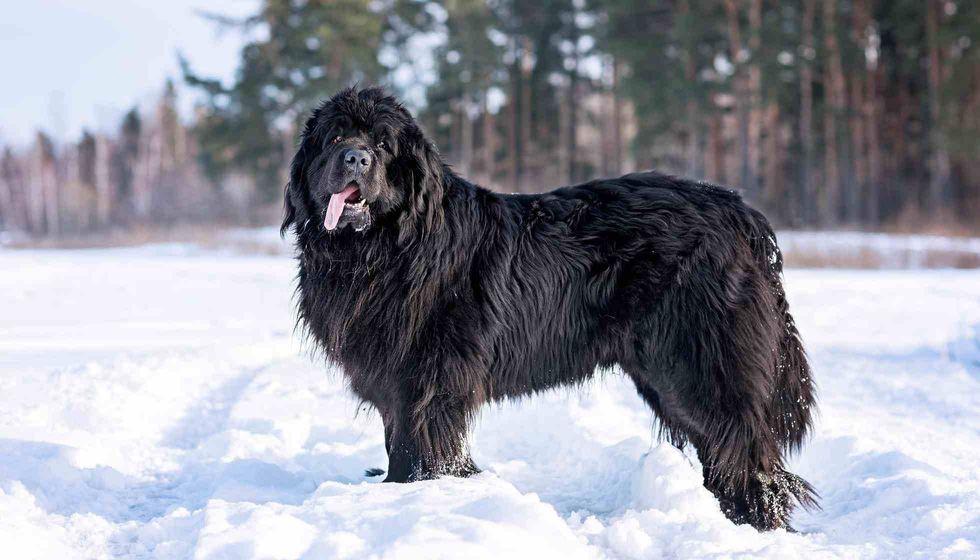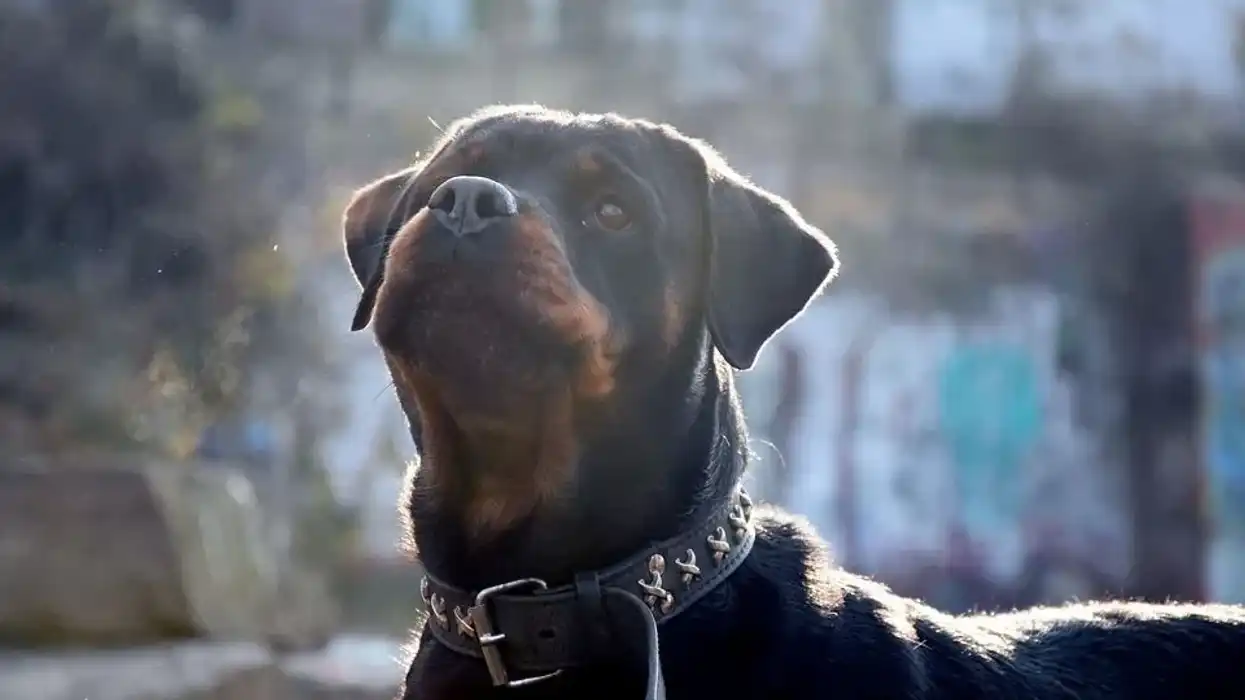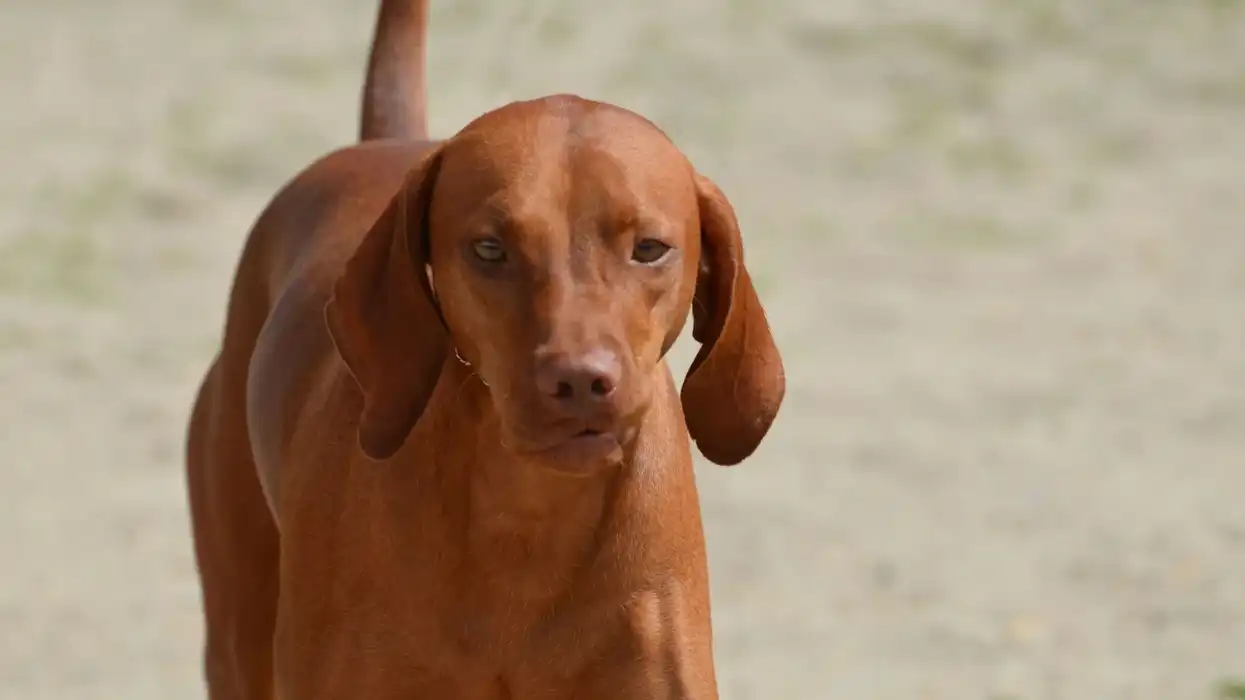The Newfoundland dog breed originated in Newfoundland as a working dog for fishermen. These dogs are huge in size and can be up to 28 inches tall. They have a strong muscular body, which made them ideal as working dogs. Their temperament and laid-back attitude also make them a favorite among people.
The exact Newfoundland dog origin and history are not known. Most of the theories suggest that in the early 18th century, explorers of Irish and English origin traveled to Newfoundland. Here, they found two kinds of working dogs.
One working dog was heavier and had a long coat, while the other dog was smaller in build. The former is thought to be the Newfoundland dog we see today.
Some theories also suggest that these giant dogs descended from the Tibetan mastiff. Its special features allow it to swim exceptionally well and it can be classified as a water dog or water rescue dog as well. Hence, they have been used as rescue dogs throughout the world.
As pets, these dogs are well-known for their temperament. They are good with children and even other pets.
Their heavy coat needs a lot of care and it is essential to groom them on a regular basis. These dogs also need regular exercise, without which they become over-weight. Being one of the giant breeds, their personality has earned them the name 'gentle giants'.
Learn more about the huge Newfoundland dog below! If you like this article, then check out the bloodhound and the whippet.
Newfoundland Interesting Facts
What type of animal is a Newfoundland?
The Newfoundland is a large breed of dog found in North America. These dogs are known for their giant size and tranquil personality.
What class of animal does a Newfoundland belong to?
These dogs belong to the class Mammalia. They are a member of the Canidae family.
How many Newfoundlands are there in the world?
Since Newfoundlands are a domestic breed, their exact population has not been assessed. But these dogs are bred and commonly available as pets, so it can be assumed that their population is stable.
Where does a Newfoundland live?
Originally, this dog breed was produced in Newfoundland, which is a part of Canada. A major part of Newfoundland is an extended portion of the Appalachian mountain system. Since these dogs have been domesticated ever since they are now found in houses and also with breeders.
What is a Newfoundland's habitat?
Newfoundland, the place from where this dog breed originated, is characterized by a lack of native trees and wildlife.
The summers in this region are cool and the average temperature is around 61 F or 16 C. However, the winters here have severely cold weather with the temperature dropping to 32 F or 0 C. This explains why these dogs have a double coat.
Who do Newfoundlands live with?
Due to being a domestic breed, these dogs live with humans. They also get along well with dogs of their own kind and other kinds. Their nature allows them to co-exist with other types of pets as well.
How long does a Newfoundland live?
The Newfoundland dog life span usually ranges between eight and 10 years. However, some may live up to 15 years.
These dogs display a number of health conditions like hip dysplasia, hypothyroidism, cancer, gastric torsion, and so on. Though not all dogs will suffer from these conditions, it is still essential to be aware of these issues for anyone considering adopting or buying them. Regular exercise helps this breed in maintaining good health.
How do they reproduce?
In most dogs, the females have an estrous cycle twice a year. This is when they breed with the males in order to give birth. This phase can last for two or three weeks.
After fertilization, there is usually a gestation period of 58 - 68 days. Being a member of the Canidae family like other dogs, Newfoundland dogs or Newfie dogs, also follow a similar pattern. They give birth to up to 12 Newfoundland puppies.
What is their conservation status?
The conservation status of the Newfoundland dog has not been listed by the International Union for Conservation of Nature or IUCN. Being a domestic species that are bred to maintain their numbers in the market, it can be ascertained that they face no threats to their population and have a stable presence.
Newfoundland Fun Facts
What do Newfoundlands look like?

Newfoundlands are one of the giant dog breeds, so their size is massive. They are usually found in black, brown, or black and white, and gray.
The white Newfoundland dog with black markings is not as common as the solid black one. This pattern is known as the Landseer pattern. These dogs are provided with a very thick and long double coat.
The outer coat seems to be longer and is coarse to touch, while the coat below is much denser and softer. They are also gifted with unique webbed feet, making them ideal for water rescue missions.
How cute are they?
The dog breed Newfoundland appears to be very cute and charming. Owing to their size and fluffy coat, this breed seems like a huge teddy bear. The Newfoundland puppy is also extremely adorable and lovable. Their personality adds to their cuteness. Being very friendly and intelligent, these dogs are ideal as a pet.
How do they communicate?
Just like any other dog, Newfoundlands also have similar ways of expressing themselves and communicating. They generally lower and wag their tails, when happy.
They also like to lie on their backs and show their belly, when they want to be pet. If they have their tails in between their legs, it could mean they are fearing something. On the contrary, if they have their tails up high, it means they are trying to be protective.
How big is a Newfoundland?
The Newfoundland dog sizes measure 28 in (71 cm) for the males and 26 in (66 cm) for the females when standing. The labrador dog breed appears much smaller when compared to a Newfie.
How fast can a Newfoundland run?
Newfoundlands can run pretty fast, but they usually cannot cover very long distances. This breed has a low energy level and requires 30 to 40 minutes of exercise every day to stay fit.
How much does a Newfoundland weigh?
The Newfoundland dog average weight is about 130 - 150 lb (59 - 68 kg) for the males and 100 - 120 lb (45.3 - 54.4 kg) for the females. However, sometimes the Newfoundland dog weight crosses 200 lb or 90 kg. The largest Newfie weighed 260 lb or 120 kg.
What are their male and female names of the species?
The male Newfoundlands are known as dogs and the female Newfoundlands are known as bitches.
What would you call a baby Newfoundland?
A baby Newfie would be called a Newfoundland puppy.
What do they eat?
Newfoundlands require a healthy and balanced diet to take care of all their requirements. This breed of dog especially requires a lot of food during its first year.
After that, their metabolism slows down and they can consume fewer calories. They should be fed any good store-bought dog food or homemade food that also has all the components necessary for their growth and good health.
Giving them treats can be an essential part of their training. However, they should not be over-fed as that can lead to obesity and various other health concerns.
Are they slobbery?
Newfoundlands are one of those dog breeds that slobber a lot. They are known for drooling a lot, due to their lips which are drooping in nature. They are also very heat-sensitive and their drooling heightens during the summer months. Apart from this, they are also messy drinkers.
Would they make a good pet?
Newfoundlands are exceptionally good as a pet. The Newfoundland dog's temperament is quite calm and affectionate, making them an ideal pet.
If they are socialized and trained since they are a puppy, they will not display aggressive behavior. As these dogs are very intelligent, they respond well to training and are quick learners. They do have a very deep bark but aren't known to bark unnecessarily.
However, Newfoundlands need a lot of grooming. Their coat needs to be brushed at least twice a week, as they shed a lot.
Special care also has to be provided towards their health, as they are prone to several illnesses. Exercise should be made a part of their daily routine as a pet to avoid critical health conditions. Since these dogs love being in human company, they do not like being left alone for too long.
A Newfoundland dog costs $800 to $1,500. They can also be adopted from rescue centers.
Did you know...
In the famous story 'Peter Pan', the guardian dog 'Nana' belonged was a Newfoundland.
The calm and friendly nature of Newfoundlands is so well-known that they act as therapy dogs as well. In many countries, the breed standards advise not to breed aggressive Newfies any further, as their sweet personality is one of their biggest hallmarks.
An American overland expedition, which was headed by Lewis and Clark, had a Newfie by the name of Seaman, who completed the entire trip.
In 1815, a Newfie rescued Napoleon Bonaparte from drowning, while he was trying to escape from the Elba Island.
The black and white Newfies are called Landseer in honor of Sir Edwin Landseer, who often painted pictures of Newfoundlands.
Where did the Newfoundland dog get its name?
The earliest written record of this breed of dog dates back to the year 1775. An explorer and trader in Newfoundland by the name of George Cartwright named his own dog after the native location from where these dogs were found, which is Newfoundland. Since then, these dogs have been known as Newfoundlands.
How are Newfoundland dogs adapted to swimming?
The Newfoundland dog can also be called a water dog. This breed has webbed feet and a double coat which is oily, water-resistant, and thick.
In addition, their lung capacity allows them to swim great distances. The Newfoundland dog paws are specialized in such a manner, that it allows the dog to swim with the most propulsion.
Unlike other dogs who swim using a dog paddle method, the Newfoundland's feet allow them to swim using more of a breast-stroke method. For their skills in swimming, the big Newfoundland dog has been employed in several rescue missions and used as sea dogs.
Here at Kidadl, we have carefully created lots of interesting family-friendly animal facts for everyone to discover! Learn more about some other mammals including the Dogo Argentino and the Yorkshire terrier.
You can even occupy yourself at home by drawing one of our Newfoundland dog coloring pages.










